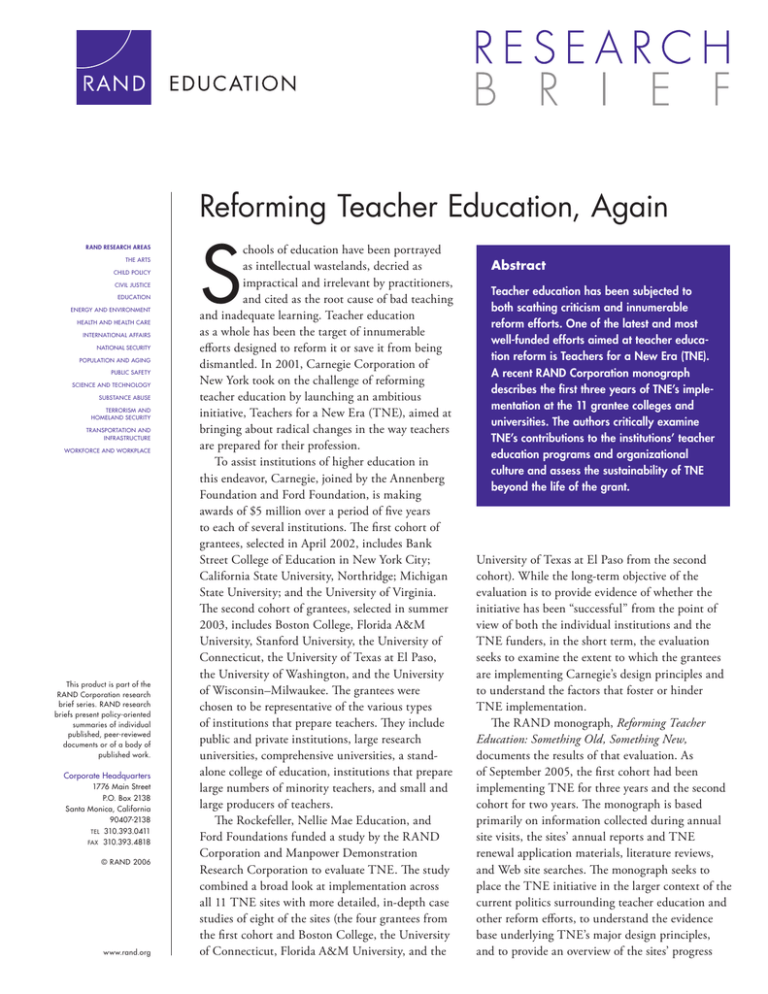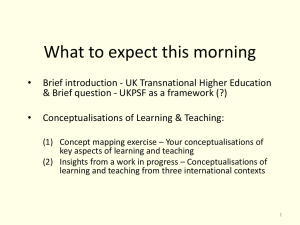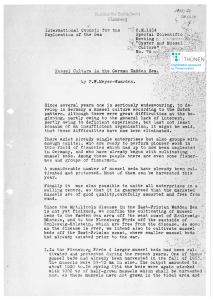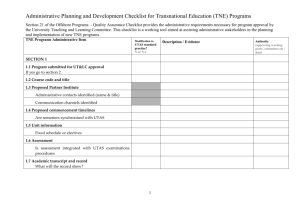S Reforming Teacher Education, Again
advertisement

Reforming Teacher Education, Again RAND RESEARCH AREAS THE ARTS CHILD POLICY CIVIL JUSTICE EDUCATION ENERGY AND ENVIRONMENT HEALTH AND HEALTH CARE INTERNATIONAL AFFAIRS NATIONAL SECURITY POPULATION AND AGING PUBLIC SAFETY SCIENCE AND TECHNOLOGY SUBSTANCE ABUSE TERRORISM AND HOMELAND SECURITY TRANSPORTATION AND INFRASTRUCTURE WORKFORCE AND WORKPLACE This product is part of the RAND Corporation research brief series. RAND research briefs present policy-oriented summaries of individual published, peer-reviewed documents or of a body of published work. Corporate Headquarters 1776 Main Street P.O. Box 2138 Santa Monica, California 90407-2138 TEL 310.393.0411 FAX 310.393.4818 © RAND 2006 www.rand.org S chools of education have been portrayed as intellectual wastelands, decried as impractical and irrelevant by practitioners, and cited as the root cause of bad teaching and inadequate learning. Teacher education as a whole has been the target of innumerable efforts designed to reform it or save it from being dismantled. In 2001, Carnegie Corporation of New York took on the challenge of reforming teacher education by launching an ambitious initiative, Teachers for a New Era (TNE), aimed at bringing about radical changes in the way teachers are prepared for their profession. To assist institutions of higher education in this endeavor, Carnegie, joined by the Annenberg Foundation and Ford Foundation, is making awards of $5 million over a period of five years to each of several institutions. The first cohort of grantees, selected in April 2002, includes Bank Street College of Education in New York City; California State University, Northridge; Michigan State University; and the University of Virginia. The second cohort of grantees, selected in summer 2003, includes Boston College, Florida A&M University, Stanford University, the University of Connecticut, the University of Texas at El Paso, the University of Washington, and the University of Wisconsin–Milwaukee. The grantees were chosen to be representative of the various types of institutions that prepare teachers. They include public and private institutions, large research universities, comprehensive universities, a standalone college of education, institutions that prepare large numbers of minority teachers, and small and large producers of teachers. The Rockefeller, Nellie Mae Education, and Ford Foundations funded a study by the RAND Corporation and Manpower Demonstration Research Corporation to evaluate TNE. The study combined a broad look at implementation across all 11 TNE sites with more detailed, in-depth case studies of eight of the sites (the four grantees from the first cohort and Boston College, the University of Connecticut, Florida A&M University, and the Abstract Teacher education has been subjected to both scathing criticism and innumerable reform efforts. One of the latest and most well-funded efforts aimed at teacher education reform is Teachers for a New Era (TNE). A recent RAND Corporation monograph describes the first three years of TNE’s implementation at the 11 grantee colleges and universities. The authors critically examine TNE’s contributions to the institutions’ teacher education programs and organizational culture and assess the sustainability of TNE beyond the life of the grant. University of Texas at El Paso from the second cohort). While the long-term objective of the evaluation is to provide evidence of whether the initiative has been “successful” from the point of view of both the individual institutions and the TNE funders, in the short term, the evaluation seeks to examine the extent to which the grantees are implementing Carnegie’s design principles and to understand the factors that foster or hinder TNE implementation. The RAND monograph, Reforming Teacher Education: Something Old, Something New, documents the results of that evaluation. As of September 2005, the first cohort had been implementing TNE for three years and the second cohort for two years. The monograph is based primarily on information collected during annual site visits, the sites’ annual reports and TNE renewal application materials, literature reviews, and Web site searches. The monograph seeks to place the TNE initiative in the larger context of the current politics surrounding teacher education and other reform efforts, to understand the evidence base underlying TNE’s major design principles, and to provide an overview of the sites’ progress –2– in implementing those principles. It also addresses the questions of sustainability of TNE and TNE’s likely long-term legacy to the field of teacher education; however, the findings are necessarily speculative, given that these questions can be addressed only in the long term. TNE Design Principles The TNE prospectus, which can be found at http://www.carnegie. org/sub/program/teachers_prospectus.html, outlines three broad design principles (or guiding themes) that Carnegie and the other TNE funders believe characterize excellent teacher education programs and to which the selected TNE sites are expected to adhere: 1. A teacher education program should be guided by a respect for evidence. A culture of research, inquiry, and data analysis should permeate the teacher education program. Attention should be given to pupil-learning gains accomplished under the tutelage of teachers who are graduates of the program. 2. Faculty in the arts and sciences disciplines must be fully engaged in the education of prospective teachers, especially in the areas of subject-matter understanding and general and liberal education. 3. Education should be recognized as an academically taught clinical-practice profession. Adherence to this principle requires close cooperation between colleges of education and the schools in which education graduates teach, appointment of “master teachers” as clinical faculty in the college of education, and a two–year “residency” induction period for graduates of a teacher education program. The TNE design principles are remarkably similar to those of several other reform efforts and teacher education accreditation organizations. But while the principles pass the test of logical reasonableness and draw from a variety of sources in the literature, the evidence supporting the principles is mixed at best. TNE builds on lessons learned from previous reform efforts. First, recognizing that a complex reform initiative requires both substantial funding and external technical assistance, TNE provides both. Second, to ensure that the TNE institutions are well positioned to undertake such an effort, TNE selected institutions that were considered among the best in their “class” of institutions and placed the grant in the provost’s office rather than in the school of education. Third, support for TNE is being fostered by informational sessions designed to engage policymakers in the initiative. The Sites’ Progress in Implementing TNE Overall, the TNE design principles fit well with the culture and “mind-set” of the TNE sites. This is partly because the sites were chosen for their alignment with these principles and partly because many of the institutions have tried in the past to implement various versions of these principles as members of other reform networks. The following sections briefly describe the sites’ progress in implementing the TNE principles. Decisions Driven by Evidence All 11 sites reported that participation in TNE has led to a growing, institution-wide respect for evidence. First, TNE has resulted in a new emphasis on the collection of multiple, reliable, and valid measures of program effectiveness in schools of education. However, securing valid evidence of the “value-added” of a program through pupil-learning gains on standardized test scores is a complex undertaking, as the sites are realizing. Second, TNE has resulted in a cultural shift across these institutions, with a new emphasis on evidence and assessment permeating many university departments, not just the teacher education programs. Third, TNE has shown the need to develop and implement integrated data systems to track students’ progress over time. Engagement of Arts and Sciences Faculty At many of the TNE sites, arts and sciences faculty are involved in teacher education program planning and evaluation, joint development of teaching and knowledge standards, joint advising, team-teaching, study groups, development of courses and sections aimed at future teachers, and other such activities. Many of these activities were occurring pre-TNE, but the sites report moresystematic involvement in these activities and a greater recognition of the need for collaboration across departments. Some sites have hired new arts and sciences faculty, who are required to spend some amount of time working on teacher education issues or acting as liaisons between their department and the teacher education department. However, junior faculty members voiced concern that the TNE work might prevent them from conducting the scholarship that is necessary for promotion and tenure. Teaching as an Academically Taught Clinical-Practice Profession The TNE sites have not been uniformly successful in implementing this principle to the degree that the funders envisaged. Most of the sites have some kindergarten through grade 12 (K–12) representatives on their work teams, but the extent to which K–12 faculty are involved varies considerably by site and across TNE teams. Regarding the hiring of K–12 teachers in residence (TIRs) at the institutions, some sites have been successful, while others have not. This is for a variety of reasons, including pay differentials and a lack of clarity about the role of TIRs in the teacher education departments. Progress on developing clinical sites (K–12 schools as learning environments for teacher candidates, K–12 faculty, and university faculty) has also been uneven. The induction (two-year residency) component of the initiative— hailed as one of the most innovative elements of TNE—has proven to be the most difficult to implement in practice. The concept was new to many of the sites, and they initially struggled to define their roles in induction and identify activities that they could actually implement and sustain. Nevertheless, some grantees have developed Web sites to provide a variety of online help with induction, set up small model induction programs in cooperating districts, and institutionalized the program by creating a master’s degree linked –3– to induction. In those cases in which an induction program has been successfully implemented, the institutions worked closely with the local school districts to address the districts’ needs and to provide support for all new teachers in the districts, not just for the institutions’ graduates. Almost all the TNE sites agree that involving arts and sciences faculty in direct induction activities, such as the supervision of student teaching, is a real challenge. In addition, state and district policy has been a barrier to implementing university-based induction programs. Sites are concerned about (1) whether there is or will be a demand for university-based support, given that states and districts offer induction programs that are mandated and offered free of charge, and (2) whether new teachers will be willing to participate in (and pay for) such programs, given that they are overwhelmed by the realities of actual classroom teaching and their state or district induction requirements. Sustainability of TNE TNE participants expressed the belief that many of the changes brought about by TNE are likely to become institutionalized over time. First, a confluence of other factors apart from TNE, such as accreditation requirements and the new demand for accountability from policymakers, parents, and students, is forcing all teacher education institutions to build comprehensive databases on their students and to collect evidence of student learning, and evidence of their program’s effectiveness, downstream from a student’s graduation date. However, it is important to note that a wide chasm exists between collecting and analyzing data and actually using the data for program improvement. Second, many accreditation bodies are now requiring all departments—not just teacher education—to examine the effectiveness of their programs and to document the quality of undergraduate education. Third, where new TNE arts and sciences faculty with an interest in or ties to teacher education have been hired, those faculty members may help sustain a culture of involvement of the arts and sciences in teacher education. Fourth, to the extent that the TNE induction programs can work with the state and districts to provide or to extend the induction offerings in ways that the state is willing to endorse and that the states and districts can financially support, the induction programs and support systems for graduates that are being designed now are likely to endure. The Likely Legacy of TNE Ultimately, TNE will be judged by its long-term impact on the field of teacher education, and, more important, its impact on the quality of teaching and learning in the nation’s schools. Thus, we need to ask what has been or will be the likely impact on the quality and retention of new teacher graduates being produced by these institutions, how improved quality and retention will translate into improvements in pupil learning, and how these new and improved methods of preparing teachers will be disseminated across the nation. Thus far, the changes in the teacher education programs due to TNE appear to be small and incremental. This is not surprising, given that these institutions were selected because they are among the best in their class of institutions. However, the process by which these incremental changes will result in highly qualified, competent teachers who will be markedly “better” than the graduates before them is not well defined. Under the TNE design, the grantees would become exemplars for other institutions. Earlier reform efforts have shown that institutions are slow to emulate one another, even if the supporting evidence is clear, and, in this case, it will be a long time before convincing evidence becomes available. Also, whether there is or will be a coherent set of activities and/or reforms that can simply be adopted by peer institutions is uncertain. Furthermore, attributing changes in these institutions solely to the influence of TNE will be difficult, since several reform efforts share the same principles. Like every other reform program, TNE has several goals. Given that among its goals are changing institutional culture, bringing new awareness of the role of all faculty members in preparing teachers, and helping to make teacher education an institutional priority, the reform is likely to be a success. With respect to whether TNE’s other goals will be met—radical changes in the way teachers are prepared, evidence that these changes will produce high-quality teachers capable of bringing about marked improvements in pupils’ learning, and clear guidance for peer institutions to adopt and to adapt the TNE design principles—the answers are less clear, and, given the less-than-stellar history and cyclical nature of past teacher education reform efforts, perhaps less optimistic. This research brief describes work done under RAND Education and documented in Reforming Teacher Education: Something Old, Something New, by Sheila Nataraj Kirby, Jennifer Sloan McCombs, Heather Barney, and Scott Naftel, MG-506-EDU (available at http://www.rand.org/monographs/MG/MG506), 2006, 216 pp., $25.00, ISBN: 978-0-8330-3982-8. The RAND Corporation is a nonprofit research organization providing objective analysis and effective solutions that address the challenges facing the public and private sectors around the world. RAND’s publications do not necessarily reflect the opinions of its research clients and sponsors. R® is a registered trademark. RAND Offices Santa Monica, CA RB-9188-EDU (2006) • Washington, DC • Pittsburgh, PA • Jackson, MS • Doha, QA • Berlin, DE • Cambridge, UK • Leiden, NL THE ARTS CHILD POLICY This PDF document was made available from www.rand.org as a public service of the RAND Corporation. CIVIL JUSTICE EDUCATION ENERGY AND ENVIRONMENT HEALTH AND HEALTH CARE INTERNATIONAL AFFAIRS NATIONAL SECURITY This product is part of the RAND Corporation research brief series. RAND research briefs present policy-oriented summaries of individual published, peerreviewed documents or of a body of published work. POPULATION AND AGING PUBLIC SAFETY SCIENCE AND TECHNOLOGY SUBSTANCE ABUSE TERRORISM AND HOMELAND SECURITY TRANSPORTATION AND INFRASTRUCTURE The RAND Corporation is a nonprofit research organization providing objective analysis and effective solutions that address the challenges facing the public and private sectors around the world. WORKFORCE AND WORKPLACE Support RAND Browse Books & Publications Make a charitable contribution For More Information Visit RAND at www.rand.org Explore RAND Education View document details Limited Electronic Distribution Rights This document and trademark(s) contained herein are protected by law as indicated in a notice appearing later in this work. This electronic representation of RAND intellectual property is provided for noncommercial use only. Permission is required from RAND to reproduce, or reuse in another form, any of our research documents for commercial use.







